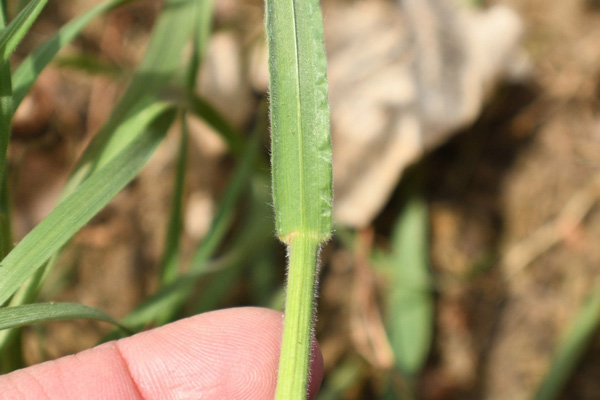Fall is a good time to control weedy annual brome species such as downy brome, Japanese brome, and cheat. These weeds are not a new problem, but an increasing number of producers are reporting an increase in these undesirable grasses emerging in thinning stands. In pastures or hayfields, young or immature annual bromes can make suitable forage, but when the plants mature, they become less palatable, as stiffened awns become a livestock hazard, and crude protein drops to less than 3%. This article will discuss some identifying characteristics for each, as well as control measures.
Identification
Three weedy brome species are prevalent in Kansas. All are winter annual species, and their seedling leaves all have a clockwise twist. Key identifying features are shown in Table 1.
- Cheatgrass (downy brome; Bromus tectorum) is covered with soft hairs on both leaf surfaces, and the closed sheath is also covered with soft hairs. Mature plants can reach up to 2 feet tall with leaves up to 5 inches long.
- Japanese brome (Bromus japonicus) seedlings are difficult to distinguish from cheatgrass, but mature plants typically grow taller than cheatgrass and have awns that are slightly bent.
- Cheat (Bromus secalinus) seedlings lack the hairy leaves and have shorter awns.
Given the challenge of distinguishing the three species, it is fortunate that most management recommendations will be similar for all three.

Figure 1. Cheatgrass (pictured) and Japanese brome have dense hairs on the upper and lower leaf surfaces as well as on the leaf sheath. Cheat has fewer hairs on the leaf, and the leaf sheath is usually hairless. Photo by Sarah Lancaster, K-State Research and Extension.
Table 1. Identifying features that distinguish among downy brome, Japanese brome, and cheat.
|
|
Cheatgrass (Downy Brome) |
Japanese Brome |
Cheat |
|
Leaf surface |
Soft, short hairs on both surfaces |
Soft hairs on both surfaces |
Occasional hairs |
|
Sheath |
Hairy |
Hairy |
Hairless to occasional hairs |
|
Ligule |
Fringed membrane |
Fringed membrane, slightly pointed |
Fringed membrane |
|
Spikelet |
Long awns (0.75 inches) |
Awns slightly bent |
Short awns (0.4 inches) |
Herbicide options
As with most weeds in perennial grass pastures or hayfields, the best management is a dense stand of the desirable forage. This means that soil fertility should be closely monitored, as well as grazing management and haying practices. In general, herbicides for weedy brome control should be applied sparingly, as they are likely to cause significant crop injury, especially in smooth bromegrass. It is also important to keep in mind that most of the products listed below are Group 2 (ALS-inhibiting) herbicides, and ALS-resistance has been confirmed in Japanese brome populations in Kansas. Weedy brome seeds remain viable approximately three years in the soil, suggesting that a few years of intensive herbicide applications, followed by forage management, can be successful.
Preemergence applications
One herbicide option is imazapic (Plateau, others; Group 2). It can be applied at 4 to 12 fl oz/A in established smooth bromegrass (not tall fescue). It must be applied in the fall before the annual brome germinates. Smooth bromegrass growth will be suppressed by applications of imazapic.
Aminopyralid (Milestone; Group 4) can be applied at 7 to 14 fl oz per acre prior to germination for suppression or control of weedy brome species. Other Group 4 herbicides, such as picloram (Tordon) and dicamba (several), may also suppress weedy brome species. Smooth bromegrass suppression is likely with these applications.
A preemergence herbicide option that is safe on smooth bromegrass or tall fescue is pendimethalin (Prowl H2O, others; Group 3). However, this product only provides weed suppression and requires about 1 inch of rainfall for activation. Pendimethalin should be applied before weeds emerge at 4 pts/A.
Postemergence applications
Propoxycarbazone (Lambient; Group 2) can be applied postemergence at 1.2 oz/A when weedy brome species are at the 2-leaf to 2-tiller growth stage. Smooth bromegrass suppression is likely to occur.
Experiments conducted in Montana suggest that picloram (Tordon 22K, others) applied at 26 fl oz/A before boot stage to Japanese brome or aminopyralid (Milestone) applied at 4 fl oz/A before heading to cheatgrass and Japanese brome will reduce seed production. Such applications may be useful for managing emerged broadleaf weeds or brush while preventing the addition of weeds to the seedbank.
Management challenges
One challenge that may arise when making herbicide applications to control weedy brome species in pastures or hayfields is the presence of a dense thatch layer. Mowing or burning prior to herbicide applications can help remove plant residue that may prevent herbicide deposition. Increasing spray volume and droplet size can also help penetrate a plant canopy or thatch layer. In addition, carefully-timed mowing can be used as a method to reduce weed seed production. Unfortunately, burning pastures in the absence of an herbicide application is likely to increase the density of weedy bromes, as burning removes barriers to germination and emergence.
Sarah Lancaster, Extension Weed Science Specialist
slancaster@ksu.edu
Tina Sullivan, Northeast Area Agronomist
tsullivan@ksu.edu